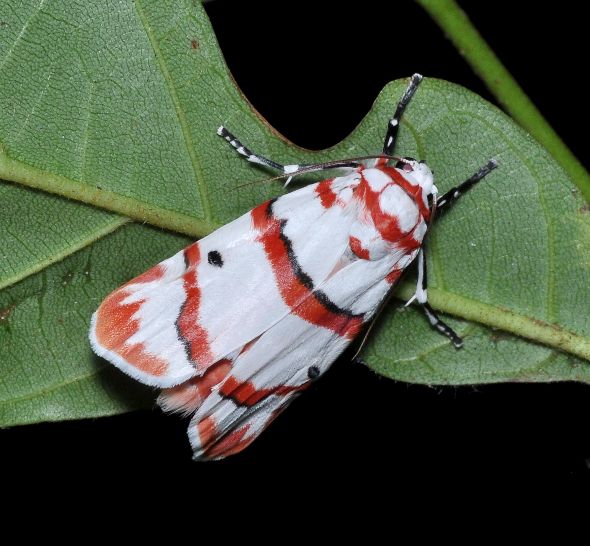On the morning of 21st October 2015, Dr V. H. Lee came across an intricate cage-like cocoon attached to a leaf in the forest around Upper Seletar (above, below). Inside this structure was a whitish pupa covered with black and yellow markings. By its side was the crumpled discarded skin of the caterpillar’s last instar covered with numerous long hairs. This was obviously a moth’s pupa.
Chan Yoke Meng took the cocoon home to photograph and hopefully, to follow the subsequent eclosure of the moth. The whitish pupa turned dark brown the next morning.
By about 2pm a yellow, legless larva-like organism was seen pushing out from the back of the pupa (above). Less than two hours later, this organism became rounded, turning deep orange (below) – another “pupa”?
In due course a fly (instead of a moth) was seen emerging from this second “pupa” (below). Strictly speaking, this was a puparium, as it belonged to a fly. Note that the newly emerged fly’s wings had yet to be fully unfolded.
Intrigued by the unique cocoon and the subsequent emergence of a fly rather than a moth, Melinda Chan trawled the internet and located two relevant papers – Leong (2010) and Leong & Woon (2010).
According to Dr Leong Tzi Ming the author, the cocoon was that of a footman moth, Cyana sp. The cocoon was constructed “out of secondary setae derived from its final instar larva” – meaning from the hairs of the caterpillar as it was turning into a pupa.
The larva-like thing that emerged from the pupa was actually a maggot of a parasitic tachinid fly, Carcelia sp. Note the two dark spots on one end of the maggot, looking like eyes. They are actually a pair of spiracles at the posterior end through which the maggot breathes.
Apparently a parasitic fly had laid its egg inside the moth’s caterpillar. When the fly egg hatched, the maggot fed on the host to emerge from within the host’s body when it was ready to pupate.
The image above is that of Cyana perornata, supplied by Tzi Ming and photographed elsewhere. All other images by Chan Yoke Meng.
Chan Yoke Meng, Melinda Chan, Dr Leong Tzi Ming & Dr VH Lee
Singapore
November 2015
References:
1. Leong, T. M., 2010. Cocoon and pupa of the moth Cyana perornata (Walker, 1854) from Singapore, with a deduction of its larval identity (Lepidoptera: Arctiidae: Lithosiinae). Nature in Singapore 3: 175-181.
2. Leong, T. M. & L. L. Woon, 2010. Larva of Cyana species moth parasitised by tachinid flies, Carcelia caudata Baranov, 1931 (Diptera: Tachinidae: Exoristinae: Eryciini). Nature in Singapore, 3: 273–276.


![Cyana sp. cocoon-pupa [ChanYokeMeng] - 1](https://besgroup.org/wp-content/uploads/Cyana-sp.-cocoon-pupa-ChanYokeMeng-1.jpg)
![Cyana sp. cocoon-pupa [ChanYokeMeng] - 2](https://besgroup.org/wp-content/uploads/Cyana-sp.-cocoon-pupa-ChanYokeMeng-2.jpg)
![Cyana sp. cocoon-pupa, fly maggot [ChanYokeMeng] - 8](https://besgroup.org/wp-content/uploads/Cyana-sp.-cocoon-pupa-fly-maggot-ChanYokeMeng-8.jpg)
![Cyana sp. cocoon-pupa, fly puparium [ChanYokeMeng]](https://besgroup.org/wp-content/uploads/Cyana-sp.-cocoon-pupa-fly-puparium-ChanYokeMeng-.jpg)
![tachinid fly [ChanYokeMeng]](https://besgroup.org/wp-content/uploads/tachinid-fly-ChanYokeMeng.jpg)








One Response
Nice page – shared across to our Facebook page – https://www.facebook.com/Tachinid-Recording-Scheme-376652392364707/